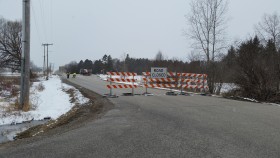Just as animals used game trails and migration routes for generations, residents and visitors of Door County have been traveling Highway 42/57 for generations. Then suddenly, beginning March 1, the barriers went up and our ancestral trail was cut off.
Does that mean that Crossroads at Big Creek is closing? No way. We hope to continue to offer programming for learners of all ages throughout construction and beyond. But Sturgeon Bay is now sort of fragmented. Our normal patterns of movement are certainly disrupted. [The DOT tells us that Michigan Street will be open until March 21, but then the barriers will go up, and our visitors will have use the detours.]
Road closures in Sturgeon Bay are not unlike the barriers created by human development. The natural landscape of Door County (and everywhere else is the developed world) is fragmented. Our peninsula once was shore-to-shore forest. Wildlife, from the smallest snails to the largest mammals, could move unrestrained. Animals could search for mates, look for food and water, escape predators. But highways, buildings, even agricultural fields isolate populations. Even populations of trees. shrubs, and wildflowers are isolated due to fragmentation. Isolated populations tend to decline, and sometimes, even become locally extinct.
We at Crossroads are delighted that for the duration of construction, the median curbs on the highway have been removed, so even during the work on the bridge and construction of the Roundabout, we will be able to travel between town and our Astronomy Campus, Big Creek Cove and the Ida Bay Preserve on Utah Street. At the north end of the construction zone, several new lanes have been created so vehicles can get off the highway and into town (and to County T, which will be the detour access to the Collins Learning Center.) So even though Sturgeon Bay is fragmented, we can get from one place to another using these new corridors.
Ecologists and wildlife managers all over the world, alarmed at the fragmentation of natural habitats, are starting to develop wildlife corridors, strips of land planted in native trees and shrubs, which serve as avenues to connect similar, but isolated, habitat areas. These plantings increase available food, provide cover, decreasing the dangers of predation, and reconnect wildlife habitats.
This year, we at Crossroads are planning to create a wildlife corridor by planting native trees and shrubs in order to connect some of our fragmented forests. But actually, when it comes to wildlife like migrating birds and butterflies, planting a variety of native plants anywhere will improve regional habitats.
On Sunday, March 13, at 4:00 Wild Ones of Door County will offer a free public lecture called “Go Native In Your Yard” Naturalist and horticulturalist Karen Newbern will share her knowledge and experience on how to be successful with native plants. She will explain that using native plants in your landscape has many benefits: for you, the wild residents of your yard, and the environment. Whether you want to attract birds and other wildlife, or are looking for a low-maintenance landscape, native plants can fit the bill and look beautiful too. Learn more about how native plantings can beautify your landscape, attract birds and butterflies, and even save money! This program is free and open to the public.
And people who plant native flowers ( and for the sake of pollinators, flowers that bloom in early spring and late fall would be good) will want to attend the Master Gardner Lecture: “A Breath of Spring: Garden Designs Using Fresh Cut Flowers and Plants” at 7:00 on Tuesday, March 15. Bette Sternard of Maas Floral and Greenhouse will bring a bit of spring to the Collins Learning Center, demonstrating creative arrangements using garden décor. Bette also will discuss elements of design and tips on using spring flowers from the garden in floral arrangements. This program is free and open to the public. (Anybody notice that on the Ides of March, the topic is CUT flowers)
Crossroads at Big Creek is a donor-supported preserve welcoming learners of all ages to programs in science, history and the environment. The Collins Learning Center, located at 2041 Michigan in Sturgeon Bay is open 2:00-4:30 daily and during scheduled events. This week, Michigan Street will be open so you can reach the Collins Learning Center from Sturgeon Bay. The median curbs on Utah Street have been removed, so for the duration of the construction, vehicles can reach our Astronomy Campus, Big Creek Cove, and the Ida Bay Preserve by crossing the highway at Utah Street.
Sunday, March 13, 4:00 Wild Ones Lecture “Go Native In Your Yard”
Naturalist and horticulturalist Karen Newbern will share her knowledge and experience on how to be successful with native plants. She will explain that using native plants in your landscape has many benefits: for you, the wild residents of your yard, and the environment. Whether you want to attract birds and other wildlife, or are looking for a low-maintenance landscape, native plants can fit the bill and look beautiful too. Learn more about how native plantings can beautify your landscape, attract birds and butterflies, and even save money! This program is free and open to the public.
Tuesday, March 15 7:00 Master Gardener Lecture: “A Breath of Spring: Garden Designs Using Fresh Cut Flowers and Plants” . Bette Sternard of Maas Floral and Greenhouse will bring a bit of spring to the Collins Learning Center, demonstrating creative arrangements using garden décor. Bette also will discuss elements of design and tips on using spring flowers from the garden in floral arrangements. This program is free and open to the public


